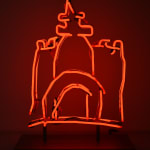Christian Jankowski
Further images
Jankowski illuminates an "untrained" sketch, emphasizing the dignity and worth of lay contributions, juxtaposed against the more traditional, elite connotations of architecture and art.
The financial model of the project underlines this theme: participants are paid based on their usual wages, which acknowledges their everyday labor's worth. Moreover, if a representation of the project (the castle) is sold, the sketcher earns a percentage similar to an architect's fee, elevating their role from mere participants to co-creators or stakeholders in the artwork.
Furthermore, the sale terms of the sculpture, which include the original sketch and build instructions, empower the collector. It allows the owner of "Luftschloss Roter Tempel" to recreate the artwork in various sizes without any restrictions, democratizing the production process and blurring the lines between artist and collector. This reflects a broader commentary on class systems within artistic and architectural contexts, where creation and ownership are typically reserved for different classes.
Provenance
Artist's Studio







